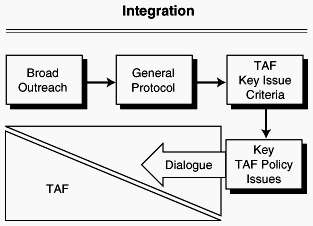


The TAF can be used as a tool to aid decision makers'
analyses.

How can the Tracking and Analysis Framework (TAF) meet decision makers' needs?

TAF is a tool to aid decision makers' analyses of the dynamics, effects, and social and economic consequences of acid deposition. Integrated assessment using TAF is therefore driven by environmental policy issues, concerns, and decisions that span a wide range of organizational and individual stakeholders.
To ensure that TAF supports priority policy concerns that are timely and appropriately addressed by a reduced-form model, "integrating" mechanisms are proposed.
These mechanisms include the identification of stakeholders and their priority issues; consideration of TAF's capabilities as compared to the context, scope, and timing of the stakeholder issue; and a framework for dialogue between decision makers and the modeling community.

Turner, R. S., W. H. Ramsey, and P. F. Ryan. 1995. Integrated assessment: Lessons learned from the National Acid Precipitation Assessment Program. First International Conference on Multiple Objective Decision Support Systems for Land, Water, and Environmental Management: Concepts, Approaches, and Applications, Honolulu, July 23-29, 1995 (submitted).
Integrated Assessment Briefs. 1995. ORNL/M-4227. Oak Ridge National Laboratory, Oak Ridge, TN.